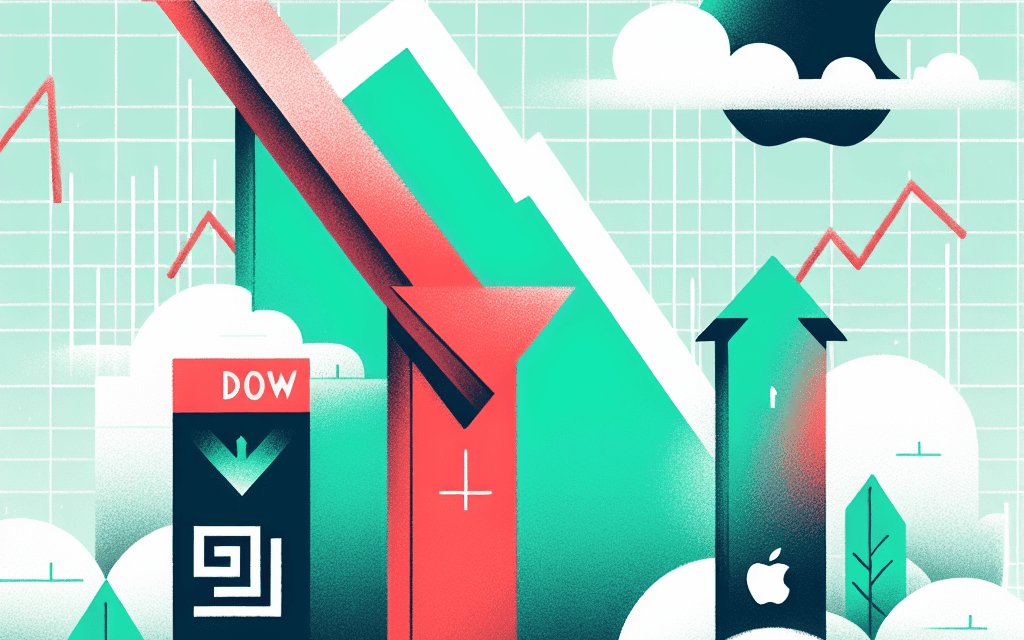“Market Jitters: Dow Dips 300 Points Amid Nvidia and Apple Surge”
Introduction
In a volatile trading session, the stock market experienced notable fluctuations as the Dow Jones Industrial Average fell by 300 points, reflecting investor concerns and market dynamics. Despite the broader market downturn, tech giants Nvidia and Apple defied the trend, reaching new all-time highs. This divergence highlights the contrasting performance within the market, where certain sectors and companies continue to thrive amid broader economic uncertainties. The decline in the Dow underscores the ongoing challenges faced by traditional industries, while the resilience of tech stocks like Nvidia and Apple emphasizes the shifting landscape of market leadership. As investors navigate these complexities, the focus remains on balancing risk and opportunity in an ever-evolving financial environment.
Impact Of Nvidia’s Surge On The Tech Sector
The recent fluctuations in the stock market have drawn significant attention, particularly as the Dow Jones Industrial Average experienced a notable decline of 300 points. This downturn, however, contrasts sharply with the remarkable performance of tech giants Nvidia and Apple, both of which have reached new all-time highs. This divergence in market behavior underscores the complex dynamics at play within the tech sector and its broader implications for investors and the economy.
Nvidia’s surge can be attributed to its continued dominance in the semiconductor industry, particularly in the realm of artificial intelligence and gaming. The company’s innovative advancements in graphics processing units (GPUs) have positioned it as a leader in these rapidly growing markets. As demand for AI-driven technologies and high-performance gaming solutions continues to escalate, Nvidia’s strategic investments and product developments have resonated well with investors, driving its stock to unprecedented levels. This upward trajectory not only reflects Nvidia’s robust business model but also highlights the increasing importance of technology in shaping future economic landscapes.
Simultaneously, Apple’s ascent to new heights is indicative of its sustained influence and adaptability in the tech sector. The company’s ability to consistently deliver cutting-edge products and services has fortified its position as a market leader. Apple’s recent product launches, coupled with its strategic expansion into services such as streaming and financial technology, have bolstered investor confidence. This diversification strategy has enabled Apple to mitigate risks associated with hardware sales, thereby enhancing its overall market resilience.
The impressive performances of Nvidia and Apple have had a ripple effect across the tech sector, influencing both investor sentiment and market dynamics. As these companies continue to thrive, they set a benchmark for innovation and growth, encouraging other tech firms to pursue similar paths of advancement. This competitive environment fosters a culture of continuous improvement, driving technological progress and economic growth. However, it also presents challenges for smaller companies striving to keep pace with industry leaders.
Moreover, the contrasting movements of the Dow and these tech giants underscore the evolving nature of market indices. While traditional sectors may face headwinds due to various economic factors, the tech sector’s resilience and growth potential offer a counterbalance. This divergence highlights the importance of diversification in investment portfolios, as reliance on a single sector or index may expose investors to heightened risks.
In addition, the tech sector’s robust performance amid broader market volatility raises questions about the sustainability of such growth. As Nvidia and Apple continue to push boundaries, concerns regarding market saturation and regulatory scrutiny may emerge. Investors and analysts alike must remain vigilant, assessing the long-term implications of these developments on both individual companies and the sector as a whole.
In conclusion, the recent market update, characterized by the Dow’s decline and the ascent of Nvidia and Apple, underscores the dynamic interplay between different sectors and their impact on the broader economy. As the tech sector continues to evolve, driven by innovation and strategic foresight, it remains a focal point for investors seeking growth opportunities. However, navigating this landscape requires a nuanced understanding of market trends and potential risks, ensuring that investment strategies are well-aligned with the ever-changing economic environment.
Apple’s Market Performance Amidst Broader Dow Decline
In the ever-evolving landscape of the stock market, fluctuations are a constant, and the recent performance of the Dow Jones Industrial Average serves as a testament to this dynamic nature. On a day marked by significant market movements, the Dow fell by 300 points, a decline that captured the attention of investors and analysts alike. Despite this broader downturn, certain stocks managed to defy the trend, with Nvidia and Apple reaching new highs, showcasing their resilience and market strength.
Apple Inc., a stalwart in the technology sector, has consistently demonstrated its ability to navigate market volatility. As the Dow experienced a notable decline, Apple’s stock performance stood out, reaching new heights and reinforcing its position as a market leader. This achievement can be attributed to several factors that have bolstered investor confidence in the company. Firstly, Apple’s continued innovation and product diversification have played a crucial role in sustaining its growth trajectory. The company’s recent product launches, including the latest iterations of the iPhone and advancements in wearable technology, have been met with positive consumer reception, translating into robust sales figures.
Moreover, Apple’s strategic focus on expanding its services segment has further contributed to its market resilience. The company’s services division, encompassing offerings such as Apple Music, iCloud, and the App Store, has witnessed substantial growth, providing a steady revenue stream that complements its hardware sales. This diversification not only mitigates risks associated with hardware market saturation but also positions Apple to capitalize on the growing demand for digital services.
In addition to its product and service innovations, Apple’s strong financial health has been a key factor in its market performance. The company boasts a formidable balance sheet, characterized by substantial cash reserves and prudent financial management. This financial strength enables Apple to invest in research and development, pursue strategic acquisitions, and return value to shareholders through dividends and share buybacks, all of which contribute to sustained investor confidence.
While Apple’s individual success is noteworthy, it is essential to consider the broader market context in which these developments occur. The Dow’s 300-point decline reflects a confluence of factors impacting investor sentiment. Concerns over global economic conditions, geopolitical tensions, and potential interest rate adjustments by central banks have collectively contributed to market uncertainty. In such an environment, investors often gravitate towards stocks with strong fundamentals and growth prospects, such as Apple, which can weather economic headwinds more effectively.
Furthermore, the performance of other technology giants, like Nvidia, underscores the sector’s resilience amidst broader market challenges. Nvidia’s rise to new highs, driven by its leadership in graphics processing units and artificial intelligence technologies, highlights the continued demand for cutting-edge tech solutions. This trend suggests that while the Dow may experience fluctuations, individual companies with robust growth strategies and market-leading positions can still thrive.
In conclusion, Apple’s market performance amidst the Dow’s decline exemplifies the company’s ability to navigate complex market dynamics successfully. Through innovation, diversification, and financial strength, Apple has maintained its appeal to investors, even as broader economic uncertainties persist. As the market continues to evolve, Apple’s strategic initiatives and adaptability will likely play a pivotal role in shaping its future trajectory, offering valuable insights into the resilience of leading technology firms in an ever-changing financial landscape.
Analyzing The Dow’s 300-Point Drop: Key Factors
The recent 300-point drop in the Dow Jones Industrial Average has captured the attention of investors and analysts alike, prompting a closer examination of the underlying factors contributing to this decline. Despite the overall downturn, it is noteworthy that tech giants Nvidia and Apple have reached new highs, underscoring the complex dynamics at play within the market. To understand the broader implications of this development, it is essential to consider both macroeconomic influences and sector-specific trends that have shaped the current market landscape.
Firstly, the broader economic environment has been characterized by a mix of optimism and caution. On one hand, recent economic data has shown signs of resilience, with consumer spending and employment figures remaining robust. However, concerns about inflationary pressures and potential interest rate hikes by the Federal Reserve have introduced a degree of uncertainty. This duality has created a challenging backdrop for investors, who must navigate the potential for both growth and volatility. The Dow’s recent decline can be partially attributed to these macroeconomic concerns, as market participants reassess their risk exposure in light of evolving economic conditions.
In addition to these overarching economic factors, sector-specific developments have also played a crucial role in shaping market movements. The technology sector, in particular, has been a focal point of investor interest, with companies like Nvidia and Apple continuing to demonstrate strong performance. Nvidia’s recent surge can be attributed to its leadership in the semiconductor industry, where demand for chips remains high across various applications, including artificial intelligence and gaming. Similarly, Apple’s continued innovation and strong consumer demand for its products have propelled its stock to new heights. These successes highlight the resilience of the technology sector, even amid broader market fluctuations.
However, not all sectors have fared as well. The financial sector, for instance, has faced headwinds due to concerns about narrowing interest rate spreads and regulatory challenges. Banks and financial institutions, which are typically sensitive to interest rate changes, have experienced pressure as investors weigh the potential impact of future monetary policy adjustments. This sector-specific weakness has contributed to the overall decline in the Dow, as financial stocks represent a significant component of the index.
Moreover, geopolitical tensions and global trade dynamics have added another layer of complexity to the market environment. Ongoing trade negotiations and diplomatic challenges have the potential to disrupt supply chains and impact corporate earnings, further influencing investor sentiment. As a result, market participants are closely monitoring developments on the international stage, as any significant shifts could have far-reaching implications for global markets.
In conclusion, the recent 300-point drop in the Dow Jones Industrial Average reflects a confluence of factors, including macroeconomic uncertainties, sector-specific trends, and geopolitical considerations. While the technology sector has shown remarkable resilience, other areas of the market have faced challenges that have contributed to the overall decline. As investors continue to navigate this complex landscape, it will be crucial to remain vigilant and adaptable, recognizing that market dynamics are subject to rapid change. By understanding the interplay of these various factors, market participants can better position themselves to respond to future developments and capitalize on emerging opportunities.
Tech Giants Leading The Charge: Nvidia And Apple

In recent market developments, the Dow Jones Industrial Average experienced a notable decline, shedding 300 points. This downturn, however, contrasts sharply with the performance of tech giants Nvidia and Apple, both of which have reached new all-time highs. This divergence underscores the complex dynamics currently at play within the financial markets, where sector-specific strengths can coexist with broader market weaknesses.
Nvidia, a leader in the semiconductor industry, has been riding a wave of optimism fueled by its advancements in artificial intelligence and data center technologies. The company’s strategic focus on AI has positioned it as a critical player in the tech ecosystem, driving investor confidence and propelling its stock to unprecedented levels. As businesses increasingly integrate AI into their operations, Nvidia’s cutting-edge GPUs and software solutions have become indispensable, further solidifying its market position. This surge in demand for AI capabilities has not only bolstered Nvidia’s financial performance but also enhanced its reputation as a pioneer in technological innovation.
Similarly, Apple continues to captivate investors with its robust product ecosystem and consistent revenue growth. The recent launch of its latest iPhone models, coupled with strong sales in wearables and services, has reinforced Apple’s status as a dominant force in the consumer electronics market. The company’s ability to maintain a loyal customer base while expanding its offerings into new areas such as augmented reality and health technology has been instrumental in driving its stock to new heights. Moreover, Apple’s commitment to sustainability and privacy has resonated with consumers and investors alike, further enhancing its brand value and market appeal.
Despite the impressive performance of these tech giants, the broader market faces challenges that have contributed to the Dow’s decline. Concerns over rising interest rates, geopolitical tensions, and potential regulatory changes have created an environment of uncertainty, prompting investors to reassess their portfolios. The Federal Reserve’s monetary policy decisions, in particular, have been a focal point for market participants, as they weigh the implications of tighter financial conditions on economic growth and corporate profitability.
In this context, the resilience of Nvidia and Apple highlights the importance of innovation and adaptability in navigating market volatility. Their ability to capitalize on emerging trends and deliver value to stakeholders serves as a testament to the strength of their business models. As the tech sector continues to evolve, companies that prioritize research and development, customer engagement, and strategic partnerships are likely to remain at the forefront of industry transformation.
Looking ahead, the performance of Nvidia and Apple may offer insights into broader market trends, particularly as investors seek opportunities in sectors with strong growth potential. While challenges persist, the enduring appeal of technology-driven solutions suggests that companies capable of harnessing these opportunities will continue to attract investor interest. As such, the market’s current dynamics underscore the need for a nuanced approach to investment, one that balances the pursuit of innovation with an awareness of macroeconomic factors.
In conclusion, the contrasting fortunes of the Dow and tech leaders like Nvidia and Apple illustrate the multifaceted nature of today’s financial landscape. As these companies push the boundaries of technology and redefine industry standards, their success serves as a reminder of the transformative power of innovation in shaping the future of markets and economies alike.
Investor Reactions To Dow’s Recent Volatility
In recent weeks, the financial markets have been characterized by a notable degree of volatility, capturing the attention of investors worldwide. The Dow Jones Industrial Average, a key barometer of the U.S. stock market’s health, recently experienced a significant drop of 300 points. This decline, however, comes amid a backdrop of contrasting performances by major technology stocks, with Nvidia and Apple reaching new all-time highs. Such a juxtaposition of market movements has prompted a range of reactions from investors, who are now grappling with the implications of these developments.
To begin with, the decline in the Dow can be attributed to a confluence of factors, including concerns over rising interest rates, geopolitical tensions, and mixed economic data. These elements have collectively contributed to a sense of uncertainty, prompting investors to reassess their portfolios and risk appetites. Despite the broader market’s downturn, Nvidia and Apple have managed to defy the trend, achieving remarkable gains. Nvidia’s ascent can be largely attributed to its strong performance in the semiconductor industry, driven by robust demand for its graphics processing units (GPUs) and artificial intelligence (AI) technologies. Meanwhile, Apple’s continued innovation and expansion into new markets have bolstered investor confidence, propelling its stock to new heights.
In light of these developments, investor reactions have been varied. On one hand, some investors view the Dow’s decline as a temporary setback, maintaining a long-term perspective and focusing on the underlying strength of the U.S. economy. They argue that the recent volatility presents a buying opportunity, particularly in sectors that have been disproportionately affected by the downturn. On the other hand, more cautious investors are adopting a wait-and-see approach, wary of potential further declines and opting to preserve capital until clearer market signals emerge.
Moreover, the contrasting performances of Nvidia and Apple have sparked discussions about the growing influence of technology stocks within the broader market. As these companies continue to innovate and capture market share, their resilience in the face of broader market challenges underscores the shifting dynamics of the investment landscape. This has led some investors to reevaluate their asset allocation strategies, with a growing emphasis on technology and growth-oriented stocks.
Furthermore, the recent market volatility has also highlighted the importance of diversification as a risk management strategy. Investors are increasingly recognizing the need to balance their portfolios across different asset classes and sectors to mitigate potential losses during periods of market turbulence. This approach not only helps to cushion against downturns but also positions investors to capitalize on opportunities in various market segments.
In conclusion, the recent 300-point drop in the Dow, juxtaposed with the record highs of Nvidia and Apple, has elicited a spectrum of reactions from investors. While some remain optimistic about the long-term prospects of the market, others are exercising caution amid ongoing uncertainties. As the financial landscape continues to evolve, investors are likely to remain vigilant, adapting their strategies to navigate the complexities of a dynamic market environment. Ultimately, the ability to respond effectively to such volatility will be crucial in achieving investment success in the months and years ahead.
Sector-Wise Breakdown Of The Dow’s Performance
In the latest market update, the Dow Jones Industrial Average experienced a notable decline, falling by 300 points. This downturn comes amidst a backdrop of mixed performances across various sectors, with some companies reaching new heights while others faced challenges. Notably, tech giants Nvidia and Apple have continued their upward trajectory, hitting new highs and demonstrating the sector’s resilience and growth potential. However, the overall market sentiment remains cautious, as investors weigh the implications of these developments on the broader economic landscape.
The technology sector, spearheaded by Nvidia and Apple, has been a significant driver of market activity. Nvidia’s impressive performance can be attributed to its strong position in the semiconductor industry, where demand for its products remains robust. The company’s advancements in artificial intelligence and gaming technologies have further solidified its market leadership, attracting investor interest. Similarly, Apple’s continued innovation and expansion into new product categories have bolstered its stock performance. The company’s recent product launches and strategic initiatives have reinforced its brand strength, contributing to its new high.
Despite the positive momentum in the technology sector, other areas of the market have faced headwinds. The financial sector, for instance, has been under pressure due to concerns over interest rate fluctuations and regulatory changes. Banks and financial institutions are navigating a complex environment, where the potential for increased regulation and economic uncertainty poses challenges to their profitability. Consequently, this sector has seen a more subdued performance, impacting the overall Dow’s trajectory.
In contrast, the healthcare sector has shown resilience, with several companies reporting strong earnings and positive outlooks. The ongoing demand for healthcare services and innovations in pharmaceuticals and biotechnology have provided a solid foundation for growth. Companies within this sector are benefiting from increased investment in research and development, as well as a focus on addressing global health challenges. This has resulted in a more favorable performance compared to other sectors, offering a degree of stability amidst market volatility.
Meanwhile, the energy sector has experienced fluctuations, influenced by global oil prices and geopolitical tensions. The sector’s performance is closely tied to external factors, such as supply chain disruptions and shifts in energy policy. As a result, energy companies have faced a challenging environment, with some experiencing declines in stock value. However, there are also opportunities for growth, particularly in renewable energy and sustainable practices, which are gaining traction as the world moves towards a greener future.
Consumer goods and retail sectors have also faced mixed results, as changing consumer preferences and supply chain issues continue to impact performance. While some companies have successfully adapted to the evolving landscape by embracing e-commerce and digital strategies, others have struggled to maintain their market share. The holiday season may provide a temporary boost, but long-term success will depend on companies’ ability to innovate and meet consumer demands.
In summary, the Dow’s recent decline of 300 points reflects a complex interplay of sector-specific dynamics and broader economic factors. While technology companies like Nvidia and Apple have reached new highs, other sectors face challenges that weigh on the overall market performance. As investors navigate this landscape, they must consider the diverse factors influencing each sector and the potential implications for future growth. The market remains a dynamic environment, where opportunities and risks coexist, requiring careful analysis and strategic decision-making.
Future Projections For Nvidia And Apple’s Stock Prices
In the ever-evolving landscape of the stock market, the recent fluctuations have captured the attention of investors and analysts alike. The Dow Jones Industrial Average recently experienced a notable decline, dropping 300 points, even as tech giants Nvidia and Apple reached new all-time highs. This juxtaposition of market movements raises intriguing questions about the future projections for Nvidia and Apple’s stock prices, as well as the broader implications for the technology sector.
To begin with, Nvidia’s ascent to new heights can be attributed to its strategic positioning in the burgeoning fields of artificial intelligence and gaming. The company’s robust portfolio of graphics processing units (GPUs) has cemented its status as a leader in these industries, driving substantial revenue growth. As AI continues to permeate various sectors, Nvidia’s products are increasingly in demand, suggesting a promising trajectory for its stock. Moreover, the company’s recent foray into the automotive sector, with its advanced driver-assistance systems, further diversifies its revenue streams and enhances its growth potential. Consequently, analysts remain optimistic about Nvidia’s future stock performance, anticipating continued upward momentum.
Similarly, Apple’s recent stock surge can be linked to its consistent innovation and strong brand loyalty. The tech giant’s ability to captivate consumers with its cutting-edge products, such as the iPhone and MacBook, has been a cornerstone of its success. Furthermore, Apple’s strategic expansion into services, including Apple Music, Apple TV+, and the App Store, has provided a steady stream of recurring revenue, bolstering its financial stability. As the company continues to invest in research and development, particularly in areas like augmented reality and health technology, it is well-positioned to maintain its competitive edge. Consequently, market analysts project a favorable outlook for Apple’s stock, with potential for sustained growth.
However, it is essential to consider the broader market dynamics that could influence these projections. The recent decline in the Dow Jones Industrial Average serves as a reminder of the inherent volatility in the stock market. Factors such as geopolitical tensions, interest rate fluctuations, and economic indicators can all impact investor sentiment and market performance. In this context, while Nvidia and Apple may exhibit strong fundamentals, external factors could introduce elements of uncertainty into their stock trajectories.
Moreover, the technology sector as a whole is subject to rapid changes and intense competition. Companies must continuously innovate to maintain their market positions, and any missteps could have significant repercussions. For Nvidia and Apple, staying ahead of technological advancements and consumer preferences will be crucial in sustaining their stock growth. Additionally, regulatory challenges, particularly in areas like data privacy and antitrust, could pose potential risks to their operations and valuations.
In conclusion, while Nvidia and Apple’s recent stock performances have been impressive, future projections must account for a myriad of factors. Both companies are well-positioned to capitalize on emerging trends and maintain their leadership in the technology sector. However, investors should remain vigilant, considering both the opportunities and challenges that lie ahead. As the market continues to evolve, the ability to adapt and innovate will be key determinants of their long-term success. Thus, while optimism prevails, a cautious approach is warranted in navigating the complexities of the stock market.
Q&A
1. **What caused the Dow to fall 300 points?**
The Dow fell 300 points due to a combination of factors, including investor concerns over economic data, interest rate hikes, or geopolitical tensions.
2. **How did Nvidia perform in the market update?**
Nvidia hit a new high, indicating strong performance and investor confidence in the company’s growth prospects.
3. **What was Apple’s market performance during this update?**
Apple also reached a new high, reflecting positive sentiment and strong demand for its products and services.
4. **What sectors were most affected by the Dow’s decline?**
Sectors such as industrials, financials, or energy might have been most affected, contributing to the Dow’s decline.
5. **Were there any significant economic reports influencing the market?**
Yes, significant economic reports such as employment data, inflation figures, or GDP growth could have influenced market movements.
6. **How did other major indices perform in comparison to the Dow?**
Other major indices like the S&P 500 and Nasdaq might have experienced mixed results, with some sectors gaining while others declined.
7. **What are analysts predicting for the market’s future performance?**
Analysts might predict continued volatility with potential for recovery, depending on economic indicators and corporate earnings reports.
Conclusion
The market update indicates a mixed performance, with the Dow Jones Industrial Average falling by 300 points, suggesting a decline in investor confidence or reaction to broader economic concerns. Despite this downturn, individual stocks like Nvidia and Apple reached new highs, highlighting strong investor interest and confidence in these companies’ growth prospects and market positions. This divergence suggests that while the overall market may be experiencing volatility, certain sectors or companies, particularly in technology, continue to demonstrate resilience and attract investment.





